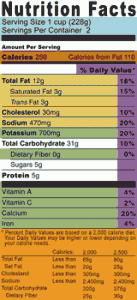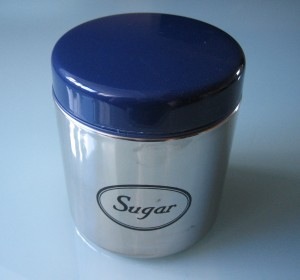Trying to interpret the carbohydrates on nutrition facts labels can be downright confusing. There’s a number for total carbohydrates but then there are subheadings for dietary fiber, sugars, and sometimes insoluble fiber, sugar alcohols, and other carbohydrates.
What Does Everything Mean?
- Total Carbohydrate, shown in grams, is first. It gives you the total number of usable carbs per serving. This number includes starches, complex carbohydrates, dietary fiber, added sugars, and non-digestible additives.
- The subheadings under Total Carbohydrate are Dietary Fiber, sometimes broken down into Soluble and Insoluble Fiber; Sugars; and sometimes categories for Sugar Alcohols and/or Other Sugars. The sum of these numbers will not always equal the total carbs because starches (types of carbs often used as binders or thickeners) aren’t required to be listed on food labels.
- Dietary Fiber, shown in grams, gives you the amount of fiber per serving. Dietary fiber is indigestible, usually passes through the intestinal tract without being absorbed, doesn’t raise your blood sugar levels, and slows down the impact of the other carbs in a meal. Subtracting the non-impact carbs – the ones that don’t affect blood sugar (fiber and sugar alcohols) from the total carbs gives you the number of net (also called usable or impact) carbs – the ones that do affect your blood sugar.
- Sugars gives you the total amount of carbohydrate, in grams, from naturally occurring sugars like lactose (milk sugar) and fructose (fruit sugar) PLUS any added sugars like high fructose corn syrup, brown and white sugar, cane juice, etc. Added sugars are the sugars and syrups added to foods during processing or preparation. They add calories but little or no nutrients.
- You can determine if there are a lot of added sugars by checking the product’s ingredients label. Ingredients are listed in order of quantity so if added sugars (white/brown sugar, corn syrup, etc.) are listed in the top three or four ingredients you can guess that the bulk of the sugars are added, not naturally occurring.
- Some products, although not all, separately list Sugar Alcohols. You might see mannitol, sorbitol, xylitol, erythritol, and others on the ingredients label. If the package says the product is “sugar-free” or has “no sugar added” it must list the sugar alcohols in the ingredients. If more than one type of sugar alcohol is listed, there must be a line for sugar alcohol grams on the nutrition label.
- Other Carbohydrates shows the number of digestible complex carbohydrates not considered a sugar (natural or added) and includes additives like stabilizers and starchy thickening agents.


